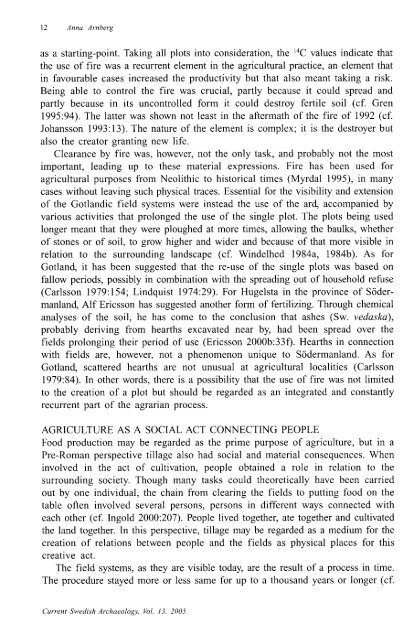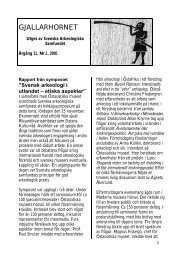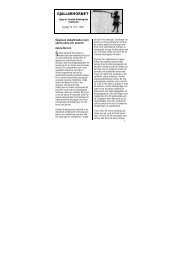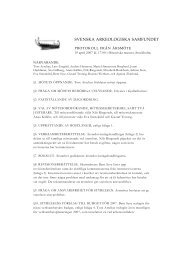Fields, Funerals and Furnaces Anna Arnberg - Svenska ...
Fields, Funerals and Furnaces Anna Arnberg - Svenska ...
Fields, Funerals and Furnaces Anna Arnberg - Svenska ...
You also want an ePaper? Increase the reach of your titles
YUMPU automatically turns print PDFs into web optimized ePapers that Google loves.
12 <strong>Anna</strong> <strong>Arnberg</strong><br />
as a starting-point. Taking all plots into consideration, the '4C values indicate that<br />
the use of fire was a recurrent element in the agricultural practice, an element that<br />
in favourable cases increased the productivity but that also meant taking a risk.<br />
Being able to control the fire was crucial, partly because it could spread <strong>and</strong><br />
partly because in its uncontrolled form it could destroy fertile soil (cf. Gren<br />
1995:94).The latter was shown not least in the aftermath of the fire of 1992 (cf.<br />
Johansson 1993:13).The nature of the element is complex; it is the destroyer but<br />
also the creator granting new life.<br />
Clearance by fire was, however, not the only task, <strong>and</strong> probably not the most<br />
important, leading up to these material expressions. Fire has been used for<br />
agricultural purposes from Neolithic to historical times (Myrdal 1995), in many<br />
cases without leaving such physical traces. Essential for the visibility <strong>and</strong> extension<br />
of the Gotl<strong>and</strong>ic field systems were instead the use of the ard, accompanied by<br />
various activities that prolonged the use of the single plot. The plots being used<br />
longer meant that they were ploughed at more times, allowing the baulks, whether<br />
of stones or of soil, to grow higher <strong>and</strong> wider <strong>and</strong> because of that more visible in<br />
relation to the surrounding l<strong>and</strong>scape (cf. Windelhed 1984a, 1984b). As for<br />
Gotl<strong>and</strong>, it has been suggested that the re-use of the single plots was based on<br />
fallow periods, possibly in combination with the spreading out of household refuse<br />
(Carlsson 1979:154; Lindquist 1974:29). For Hugelsta in the province of Södermanl<strong>and</strong>,<br />
Alf Ericsson has suggested another form of fertilizing. Through chemical<br />
analyses of the soil, he has come to the conclusion that ashes (Sw. vedaska),<br />
probably deriving from hearths excavated near by, had been spread over the<br />
fields prolonging their period of use (Ericsson 2000b:33f). Hearths in connection<br />
with fields are, however, not a phenomenon unique to Södermanl<strong>and</strong>. As for<br />
Gotl<strong>and</strong>, scattered hearths are not unusual at agricultural localities (Carlsson<br />
1979:84). In other words, there is a possibility that the use of fire was not limited<br />
to the creation of a plot but should be regarded as an integrated <strong>and</strong> constantly<br />
recurrent part of the agrarian process.<br />
AGRICULTURE AS A SOCIAL ACT CONNECTING PEOPLE<br />
Food production may be regarded as the prime purpose of agriculture, but in a<br />
Pre-Roman perspective tillage also had social <strong>and</strong> material consequences. When<br />
involved in the act of cultivation, people obtained a role in relation to the<br />
surrounding society. Though many tasks could theoretically have been carried<br />
out by one individual, the chain from clearing the fields to putting food on the<br />
table often involved several persons, persons in different ways connected with<br />
each other (cf. Ingold 2000:207). People lived together, ate together <strong>and</strong> cultivated<br />
the l<strong>and</strong> together. In this perspective, tillage may be regarded as a medium for the<br />
creation of relations between people <strong>and</strong> the fields as physical places for this<br />
creative act.<br />
The field systems, as they are visible today, are the result of a process in time.<br />
The procedure stayed more or less same for up to a thous<strong>and</strong> years or longer (cf.<br />
Current Swedish Archaeology, Voh /3, 2005






